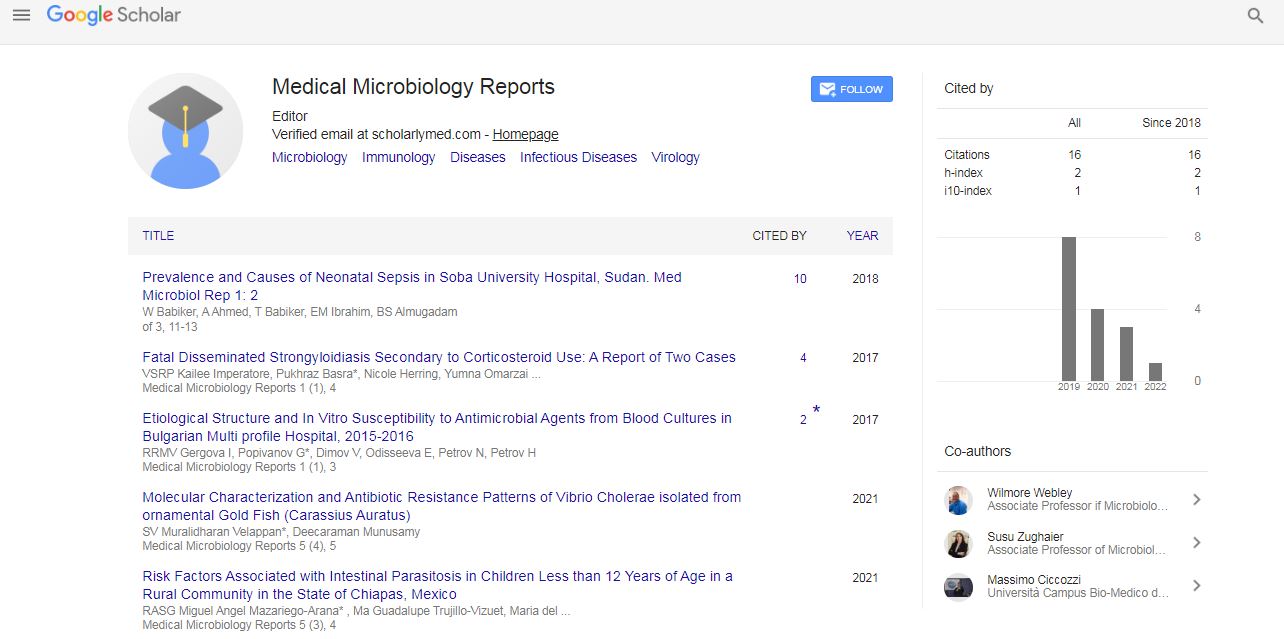Commentary, Med Microbiol Rep Vol: 6 Issue: 2
The Role of Bacterial Metabolism in the Organism
Robert*
Department of Biology, McMaster University, Hamilton, Ontario, Canada
*Corresponding Author:Robert
Department of Biology, McMaster University, Hamilton, Ontario, Canada
Email: robert97@yahoo.com
Received date: 28 February, 2022, Manuscript No. MMR-22-59653;
Editor assigned date: 03 March, 2022; Pre QC No. MMR-22-59653 (PQ);
Reviewed date: 14 March, 2022, QC No. MMR-22-59653;
Revised date: 21 March, 2022, Manuscript No: MMR-22-59653 (R);
Published date: 28 March, 2022, DOI: 10.4172/mmr.1000316.
Citation: Robert (2022) The Role of Bacterial Metabolism in the Organism. Med Microbiol Rep 6:2.
Keywords: Bacterial Metabolism
Introduction
Metabolism refers to all the biochemical reactions that arise in a mobile or organism. The study of bacterial metabolism makes a specialty of the chemical diversity of substrate oxidations and dissimilation reactions (reactions by means of which substrate molecules are broken down), which generally function in microorganism to generate electricity. Additionally within the scope of bacterial metabolism is examine of the uptake and utilization of the inorganic or organic compounds required for growth and protection of a cell constant nation (assimilation reactions). Those respective exergonic (energy-yielding) and endergonic (electricity-requiring) reactions are catalyzed in the residing bacterial cellular through included enzyme structures, the cease result being self-replication of the cell. The functionality of microbial cells to stay, function, and reflect in the ideal chemical milieu (inclusive of a bacterial way of life medium) and the chemical modifications that end result during this alteration constitute the scope of bacterial metabolism. The bacterial mobile is a relatively specialized energy transformer. Chemical strength generated by means of substrate oxidations is conserved by using formation of high-electricity compounds along with Adenosine Diphosphate (ADP) and Adenosine Triphosphate (ATP) or compounds containing the thioester bond. Kluyver and Donker (1924 to 1926) identified that bacterial cells, irrespective of species, had been in lots of respects comparable chemically to all different living cells. For instance, those investigators diagnosed that hydrogen transfer is a not unusual and fundamental function of all metabolic procedures. Microorganism, like mammalian and plant cells, uses ATP or the excessive-strength phosphate bond (~P) as the primary chemical energy source. Bacteria additionally require the B-complex nutrients as useful coenzymes for plenty oxidation-discount reactions needed for growth and energy transformation. An organism along with Thiobacillus thiooxidans, grown in medium containing handiest sulfur and inorganic salts, synthesizes big amounts of thiamine, riboflavin, nicotinic acid, pantothenic acid, pyridoxine, and biotin. Consequently, Kluyver proposed the solidarity principle of biochemistry, which states that all primary enzymatic reactions which support and keep existence techniques within cells of organisms, had extra similarities than variations. This concept of biochemical team spirit inspired many investigators to apply microorganism as version structures for analyzing related eukaryotic, plant and animal biochemical reactions which might be essentially "same" at the molecular level.
Heterotrophic Metabolism
Heterotrophic microorganisms, which include all pathogens, reap energy from oxidation of organic compounds. Carbohydrates (in particular glucose), lipids, and protein are the maximum typically oxidized compounds. Biologic oxidation of these organic compounds through microorganism effects in synthesis of ATP because the chemical strength source. This procedure additionally allows technology of less complicated organic compounds (precursor molecules) wished by means of the bacteria mobile for biosynthetic or assimilatory reactions. The Krebs cycle intermediate compounds function precursor molecules (constructing blocks) for the strength-requiring biosynthesis of complicated organic compounds in microorganism. Degradation reactions that simultaneously produce strength and generate precursor molecules for the biosynthesis of latest mobile elements are called Amphibolic. All heterotrophic microorganisms require preformed organic compounds. Those carbon and nitrogen-containing compounds are growth substrates, which might be used aerobically or anaerobically to generate lowering equivalents (e.g., decreased nicotinamide adenine dinucleotide; NADH + H+); those decreasing equivalents in turn are chemical electricity sources for all biologic oxidative and fermentative structures. Heterotrophs are the most normally studied microorganism; they develop without difficulty in media containing carbohydrates, proteins, or different complicated nutrients consisting of blood. Additionally, growth media may be enriched with the aid of the addition of different naturally going on compounds which include milk (to have a look at lactic acid bacteria) or hydrocarbons (to study hydrocarbon-oxidizing organisms).
Electron shipping and Oxidative Phosphorylation
The final stage of respiration takes place through a chain of oxidation-reduction electron transfer reactions that yield the strength to pressure oxidative phosphorylation; this in turn produces ATP. The enzymes involved in electron delivery and oxidative phosphorylation reside on the bacterial inner (cytoplasmic) membrane. This membrane is invaginated to form systems called respiration vesicles, lamellar vesicles, or mesosomes, which feature as the bacterial equal of the eukaryotic mitochondrial membrane. Fermentation, every other instance of heterotrophic metabolism, requires an organic compound as a terminal electron (or hydrogen) acceptor. In fermentations, easy organic give up products are formed from the anaerobic dissimilation of glucose (or a few other compound). Strength (ATP) is generated thru the dehydrogenation reactions that occur as glucose is broken down enzymatically. The simple natural cease products shaped from this incomplete biologic oxidation procedure additionally serve as very last electron and hydrogen acceptors. On discount, this organic quit merchandise is secreted into the medium as waste metabolites (usually alcohol or acid). The natural substrate compounds are incompletely oxidized by means of microorganism, but yield enough electricity for microbial growth. Glucose is the maximum commonplace hexose used to look at fermentation reactions. In the past due 1850s, Pasteur demonstrated that fermentation is an important method related to the boom of particular microorganisms, and that each sort of fermentation may be described with the aid of the primary natural stop product fashioned (lactic acid, ethanol, acetic acid, or butyric acid). His studies on butyric acid fermentation led directly to the discovery of anaerobic microorganisms. Pasteur concluded that oxygen inhibited the microorganisms accountable for butyric acid fermentation because each bacterial mobility and butyric acid formation ceased whilst air changed into bubbled into the fermentation mixture. Pasteur additionally delivered the terms aerobic and anaerobic. His perspectives on fermentation are made clear from his microbiologic studies on the production of beer.
 Spanish
Spanish  Chinese
Chinese  Russian
Russian  German
German  French
French  Japanese
Japanese  Portuguese
Portuguese  Hindi
Hindi 
